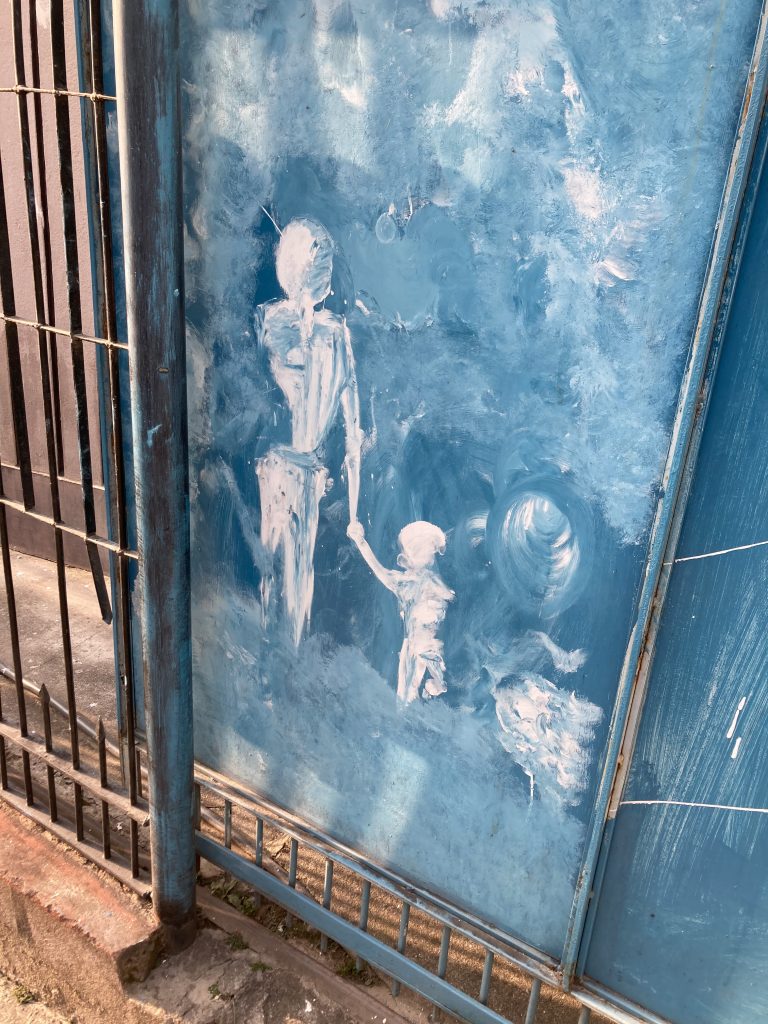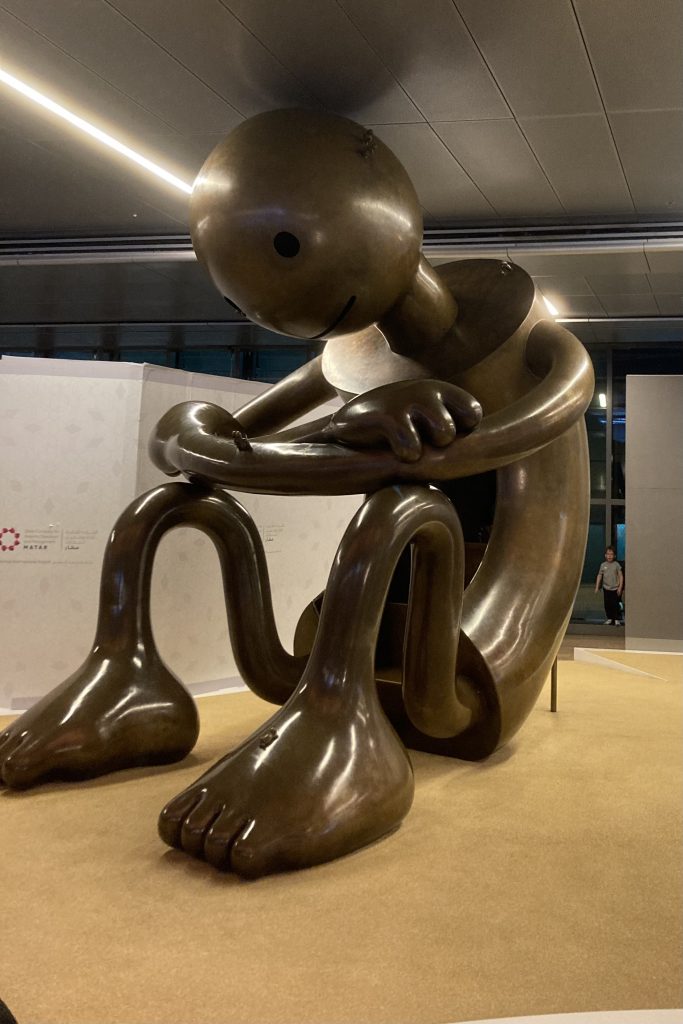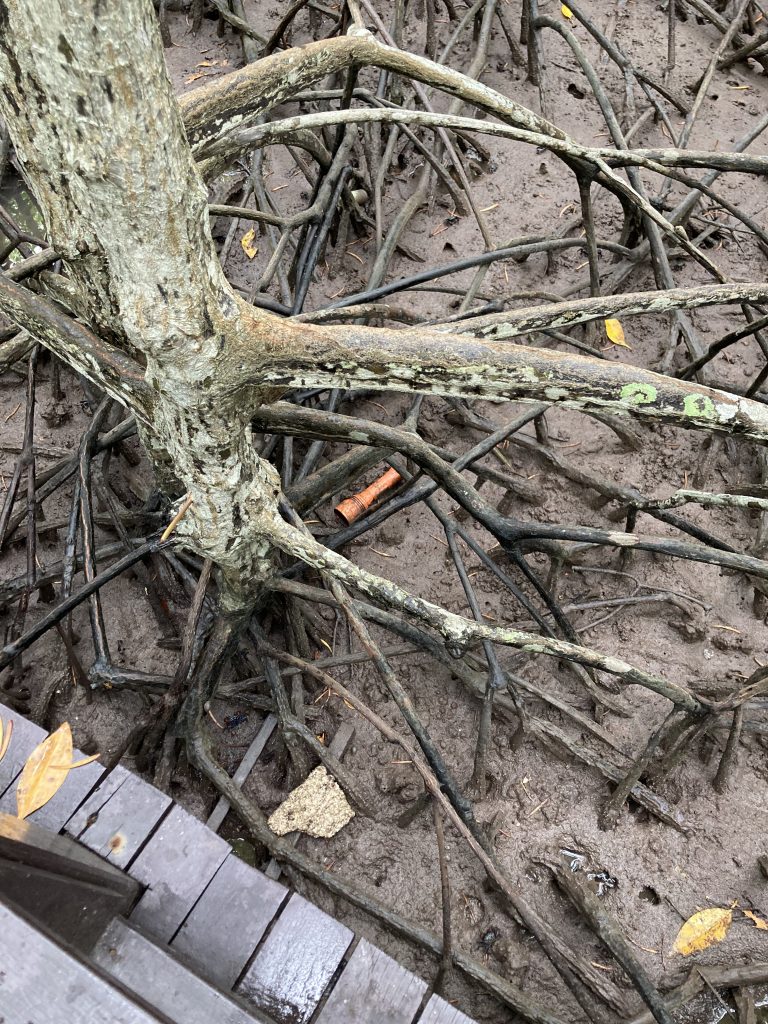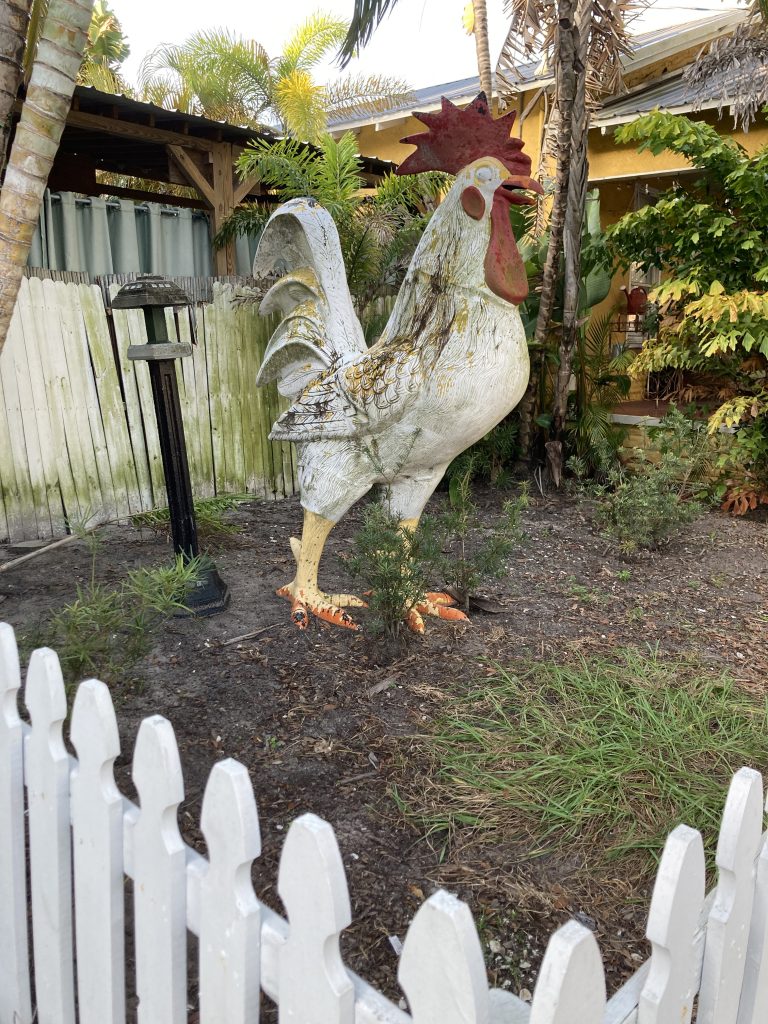no babies

The traveler explores the American Wayside, verifying the contents of a mysterious guide written by a man with whom he shares a likeness and name. Excerpts from ‘Autumn by the Wayside: A Guide to America’s Shitholes’ are italicized. Traveler commentary is written in plain text.

I wake to the shaking claustrophobia of the trunk of a car. Not my first time. Hector is in his kennel at my feet. He sniffs casually at my toes and settles back into a snooze. Not his first time either. Come to think of it, he spends much of his time in a shaking cage at the back of the motorcycle where the air is fresh, at least.
I probably should have re-homed him before something like this happened.
A low, sustainable worry persists in the back of my mind as I check the usual means of escape and find them unlikely to work. The trunk is secured closed. My hands are tied behind my back. My pockets have been emptied of everything that might prove useful. Nothing to do but wait and worry just enough.
The worry spikes a bit when the car stops. Spikes a little harder when I hear the sound of a woman crying near the car. Someone, the Stranger, exchanges words with another man. They come to some agreement, change their tones to gratitude, and the car begins to move again. The voices, the man and the crying woman, fade.
Over the next fifteen minutes there are more. Two men scream at each other. Something shatters against the side of the car and someone shouts an apology. There is a lot more crying before we seem to pull away from people altogether. I think about how thirsty I am- quite. I gauge my hunger- peckish. Without being able to see my watch I’d say I’ve been in the car a few hours at most and I put together where the Stranger has taken me. It was where I’d been heading anyway.
‘Going by many names as a necessity, ‘The Break-Up Arches’ describes a recurring series of sandstone formations, large enough to permit two or three people but small enough that, when a given arch invariably collapses, unlucky visitors are more likely to receive serious injuries rather than, say, die.
Why stand there at all? For the pictures, obviously, or for the promise of pictures that do not come since few will stoop to bringing a photographer to document one of the most raw, if common, romantic experiences.
‘The Break-Up Arches’ is a place for ending relationships, made famous by a very early attempt at a wedding, this one forever preserved in black and white film. The picture captures the chaotic moment when the bride-to-be experiences her the last straw as it pertains to the slovenly-looking man beside her. He reels from something she has spit in his face. She turns, preparing to walk off. The arch above them is cracked through, is coming down on top of them both.
Circulation of the picture, newly digitized, in the early 2000s sparked a tradition for taking a ‘loved one’ to ‘The Break-Up Arches’ to call it quits, the reasoning being that the blow will be softened by the amount of thought and care it takes to orchestrate such an end or that the sandstone holds calming properties or that it just makes it easier to start the conversation, given that there will be a half dozen other howling couples around to get the point across.
Nobody said the reasoning was good, but the state of Utah seems to support it. They change the name of ‘The Break-up Arches’ on all roadside signage at the start of each season, giving it the name of a forlorn poet so as not to raise suspicion about whatever spontaneous road trip one unhappy lover has arranged for the other.’
It’s not a bad place to kill a person, really. People will be seeking privacy. People will be screaming and crying. Arches will fall and, despite what the guide says, it’s only a matter of time before they bury a person alive. The Stranger can torture me, kill me, and bring an arch down over my body. He’ll be across the country before they even consider it might be foul play.
The car rolls to a stop and I prepare myself for whatever’s about to happen. I hear footsteps outside and then a knock on the trunk. The Stranger speaks:
“I know you’re waiting to hit me in there,” he says. “You’ve probably wormed your way out of the ropes and are ready to jump me with a knife you had up your ass.” A flicker of embarrassment. This guy thinks I’m way more capable than I am. “I just want to talk, so I’m going to let you out with this fancy key-fob and you’re going to come slow.”
The trunk pops and I strain quietly against the ropes that bind my wrists and ankles.
The Stranger interrupts after a few moments: “If you’re going to play hard to get I’m going to play hard too. Come on out, now, before I have to do something drastic.”
My mouth isn’t gagged but I can’t quite bring myself to explain the situation to the Stranger. Hector hisses loudly somewhere in the darkness of the trunk.
“All right,” he sighs, voice weary all of the sudden. “I guess that’s the way it is.”
There are two loud blasts- a shotgun, I think- and then absolute silence as I try not to feel where I’ve been shot. After a moment, I decide I must be dead or entirely unharmed.
Then, the first rock hits the car.
I renew my struggle against the rope as the arch comes down over the vehicle, dust trickling in through cracks in the car, old and new. When I conclude that frantic strength under immediate threat of death is no better than the frantic strength I had used on the drive over (and under a more long-term threat of death), I notice that the arch has stopped falling and I’ve survived that as well.
It takes a few hours, but eventually I pry my shoe off and unlock Hector’s cage with my toes and slowly undo weeks of don’t-chew-rope training by convincing Hector that the rope around by wrists is actually fair game. Another hour of scrabbling in dust and stone and we surface under a starry sky and to the sound of some broken-hearted man whimpering nearby. He helps us the rest of the way out and we pay back the favor by listening to the sad story of how he emotionally neglected some poor woman for a year before she drove him to the arches to break it off.
Once I convince him there will be other woman to neglect in the future, I go about digging Hector’s kennel out of the trunk and my bag from the passenger seat of the crushed rental. My bike is, unsurprisingly, nowhere in sight. I pull up an app on my phone and see it, or at least the small knock-off GPS locator I stuck under the seat, is heading west.
It’s midnight by the time I slump back in the rubble and scratch Hector’s head. Then, it hits me.
Maybe he did just want to talk.
-traveler

‘‘Oh, you think nature is the only force that can create a proper waterfall? You think natural waterfalls are superior to manmade falls by default? You don’t think that the same civilization that harnessed atomic energy, that carved the faces of dead men into a mountain, that molded chickens into monstrous meat-fruits, can also make some water pour from a high place to a low one?’
This is the attitude with which ‘Grace Falls,’ an artificial waterfall placed, ostentatiously on the outskirts of Las Vegas, was constructed. Thirty stories high. One hundred feet wide. An average flow of 115,000 cu ft/s and pressurized such that its water doesn’t fall, exactly, but is jettisoned downward onto a reinforced cement floor where it vaporizes into a fine mist that occasionally coagulates into a vicious, if not predictable, thunderstorm.
‘It is the horrific reversal of a hydroelectric dam, wasting energy and water alike,’ raves The Clean Energy Coalition (‘raves,’ here, being used in the less positive, near hysterical sense).
What The Clean Energy Coalition can’t deny (though they’ve tried) is that ‘Grace Falls’ is a fairly impressive feat of engineering and it is absolutely mind-boggling to see in life. It roars like a tornado- is capable of bursting a man’s ear drums if said man were to approach the fall’s landing. It is capable of pressing a man’s body through a metal grate, effectively turning him into a series of gruesome hot dogs if said man, disoriented from the damaged ear drums, were to continue to charge forward under the water. It is capable of turning the man’s wife and eldest son into hot dogs as well, and the family’s lawyer too, as was demonstrated by a freak accident that wildly benefited those who own and operate ‘Grace Falls’ some weeks after the initial, less suspicious freak accident.
‘It will turn you into hot dogs,’ reads a sign just past the lower lookout and often obscured entirely by the mist, ‘It will turn everything you love into tubes.’
-an excerpt, Autumn by the Wayside.

‘A decade on, ‘The Poetry Silo’ is less an exhibit and more a warehouse for storing the world’s largest roll of thermal paper, making it something of a hybrid stop by Wayside standards. Those who come to view the enormity of the roll- to gawk at the constant pace and precise movements of the poetry receiver- are likely experiencing a fairly normal roadside attraction. Much of ‘The Poetry Silo’s’ facilities are dedicated to these people because they spend a lot less time and a lot more money than most of the Wayside travelers who come to read and, even worse, comprehend the words being spouted by the poet.
The poet is nothing more than a receipt printer gone awry in such a way that it mocks coherency. It babbles about the history of the world, pulling off neat metaphors and complex rhyme schemes just often enough to make up for the nonsense it tends to espouse otherwise. Members of certain factions would tell you that the nonsense is all just technique that has yet to reach fruition, the suggestion being that it might be a part of a very long metaphor or a very very complex rhyme scheme. Madness is just unfinished genius, they will say, and of course nobody can prove them wrong because several other factions carefully guard the poetry wheel, insisting it can’t be examined in full until the poem is complete.
As it stands, nearly 75% of the poem has been conclusively recorded elsewhere, initially by scribes and now via a specially programmed stream cam (and the scribes, still, but their work is redundantly spiritual). The missing 25% is all nearer the center of the wheel- output from the first few years when nobody paid the poet much attention, thinking it would give up sooner rather than later. Only the first line is still exposed- a little slip of paper readable from the hollow at the center. It says: ‘First let me tell you a thing you should know-’’
The trouble with getting into ‘The Poetry Silo’ these days is that there is an enormous waitlist, made tremendously long for people who can’t claim to be a member of one of the many quasi-religious factions that seek truths in the words of the poet and, therefore, receive priority access. My arrival is the culmination of a year’s work, insinuating myself into the most inclusive of these factions, the Nowists, whose particular urgency is due to their belief that the only important words in ‘The Poetry Silo’ are those between the poet and the wheel. The real poem is an ever-adapting prophecy, the meaning of which can only be deciphered by the individual reading it in the moment.
It’s a pretty thought and one that tends to generate a lot more hand-wringing and a lot fewer turf-wars than any of the other factions who want to expose or keep hidden the words in the center of the wheel.
So, I’ve spent some time in the Nowist forums and have even attended a few meet-ups when they’ve aligned with my travel and now I have a reasonably believable cover as an exuberant, if novice, Nowist. When I flash my credentials at ‘The Poetry Silo’ along with the various forms necessary for religious entry, I get the usual bureaucratic hemming and hawing that the process necessitates but am actually let through fairly quickly (assuming you discount the year’s work building up to it).
What the entry doesn’t quite drive home is the actual enormity of the poetry wheel. In a decade it has reached the sort of size that gives you butterflies just looking at it and it’s somehow made bigger by the sight of the burned-out little receipt printer that chugs along, spewing words onto specially grafted thermal paper wheels so that there are no gaps in its telling.
When the initial awe wears off I step up close to the visible strip of poem as any good Nowist would be expected to do and I keep Hector tight on his leash in case he gets any ideas. It takes me a moment to remember to read the thing wheel-to-printer and another to pace my reading with the speed at which words are spewed forth and it’s around that time that I recognize at least three metaphors for the Stranger and at least a little foreshadowing of the imminent danger presented by himself, resurrected, and his silky/dark demon rabbit thing.
By then, they are on me.
-traveler

I’m not spooked by the offerings of ‘The Gift Shop,’ at least not as immediately spooked as several testimonials suggest I ought to be. Like any gift shop, the items on display are specific enough to mark the occasion for which they are purchased, but not so specifically tailored to individual experience as to be uncanny or even really all that meaningful.
And maybe it’s a quirk of my life that leads to this initial anti-climax. ‘The Gift Shop’ is a Wayside destination and its offerings are souvenirs from roadside diners and shitty public rest stops and strikingly beautiful forests. I can see how it might be strange for someone who has lived a normal life to find postcards addressed from their kitchen and snow globes featuring the building in which they work. That’s the experience most people have, here. My journey has made it redundant. Or maybe this is its truest form. There aren’t many gift shops off the Wayside. Maybe this is how ‘The Gift Shop’ justifies its existence as part of the fragile highway ecosystem.
It’s a comforting thought, actually, because that might mean that I’m the key to aligning it.
‘Have you ever found a slip of paper on the floor of your home? A slip of paper with a series of numbers and a logo for ‘The Gift Shop’ thermally printed on the back? Fear not and keep that receipt on hand. Without it you won’t be able to claim the picture taken of you in your living room, on the toilet, sleeping soundly in your locked room, or doing any number of tasks, private and mundane. The longer you wait to claim it, the longer it sits up there on the screen for any old passerby to see.’
What gets me first is the realization that the cheap, dark-furred rabbit plushies are not dark-furred at all but sun-blackened little Hectors. With that, the uncomfortably intimate picture begins to unfold in all the little details I’ve overlooked. A t-shirt with all of the names of destinations I’ve visited so far. A bottle opener inscribed with the date I sobered up for good. A take-apart toy truck. An angry Stranger doll. A manga series where I am cast as the cynical protagonist and Hector is my wise-cracking pet.
All of the personalized pencils and pocketknives and key chains are in my name. All of the taffy is spun in flavors that I’ve tasted on the trip. Honey. Tree sap. Asphalt. Blood. There is a boardgame in the shape of the all-seeing eye. It looks boring. Everything is overpriced. The cashier is cloying in his salesmanship. I buy a pound of blood taffy so he’ll leave me alone and am off again before he can trick me into buying more.
It occurs to me, late in the evening, that I don’t think I’ve ever tasted asphalt. Not really. The thought drives me to the road which tastes much as I suspected it would.
– traveler

‘‘The Saltlick’ in eastern Wisconsin takes its name from the enriched blocks of salt humans sometimes set out for deer or livestock to see them through the winter. This is despite research that suggests it contains no sodium and ‘research’ that suggests it doesn’t taste salty at all- just nice. In fact, that ‘The Saltlick’ just tastes nice is all that people can seem to agree upon aside from its drab physical characteristics which are as follows:
It is a rough cube, four meters to a side, made smoother for the concave northeastern portion where visitors tend to lick. It is white and rough like a cat’s tongue. It doesn’t smell and is no warmer that the air around it.
It is appealing to look at- that’s something strange to say- and it’s difficult to leave un-licked. Impossible, really. There are signs up near ‘The Saltlick,’ warning visitors before they approach too close and fall under its compulsion. It’s unclear whether these signs have been posted by visitors who have undergone the lick, or those that have somehow resisted. If it’s the former, one might suspect the lickers are aware of some boon to be had by licking and are likewise aware of ‘The Saltlick’s’ massive, but limited, supply. It it’s the latter, well, perhaps the licking changes a person. Perhaps it changes a person in ways only unlicking loved ones can see. And maybe they have a point. Nobody puts up signs encouraging visitors to lick ‘The Saltlick.’ It does fine on its own.
People who have engaged tongue-wise with ‘The Saltlick’ show minor, but lasting health improvements. No miracle cures, of course. Nothing is that simple. It tends to right vitamin deficiencies. It tends to lower blood pressure.
The traditional saltlick is set out by farmers. Ranchers. Deer-leaning nature voyeurs. The most powerful argument against visiting ‘The Saltlick’ can be found on the final sign warning of its proximity. It asks:
‘Who set this out for you?’
-an excerpt, Autumn by the Wayside
© 2024 · Dylan Bach // Sun Logo - Jessica Hayworth